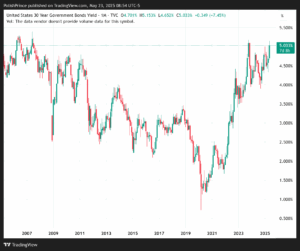
On this (and every) Memorial Day, we honor and reflect upon those who lived by their promises – those who laid down their lives in service to our country. We remember and deeply hold in our prayers the families of our fallen soldiers. It’s their bravery, resilience, and our commitment to keeping their memory eternal that ensure the freedoms we cherish today. We extend our deepest gratitude to all who made the ultimate sacrifice, and to their families, this Memorial Day.
Weekly Market Recap
Stocks edged lower this week, with the S&P 500 declining less than -1%. Smaller companies underperformed, while the Nasdaq Index continued its relative strength. Factors like Low Volatility, Growth, and Momentum outperformed, while Equal Weight and High Beta lagged. Defensive sectors slightly outperformed, whereas Energy and Real Estate sectors saw notable declines.
The bond market took center stage after Moody’s downgraded U.S. debt, driving Treasury yields sharply higher. Long-duration Treasuries and corporate bonds underperformed, whereas short-duration bond proxies remained stable. Volatility indicators rose modestly after recent calm periods, reflected in elevated VIX and MOVE indices. Concurrently, the U.S. dollar weakened amid escalating fiscal worries.
Key Takeaways
1. U.S. Credit Rating Downgraded
Moody’s downgraded the U.S. credit rating by one notch, removing the country’s final AAA rating from a major agency, citing unsustainable deficits, rising debt, and political dysfunction including repeated debt ceiling clashes.
Implication: The downgrade highlights mounting concerns around U.S. fiscal health, potentially influencing investor confidence and long-term financing costs.
2. Tax Cuts and Fiscal Responsibility Debates Intensify
Congress debates extending the Trump-era tax cuts, projected to increase the national debt by $3 – 5 trillion over ten years. The House passed a version, but Senate approval faces significant hurdles amid Republican calls for fiscal prudence.
Implication: Legislative uncertainty and potential fiscal deterioration may weigh on investor sentiment, intensifying bond market volatility.
3. Fed Maintains Patient Stance
Fed officials reiterated their cautious approach to future rate cuts, emphasizing dependence on economic data and continued tariff-related uncertainty. Immediate cuts appear unlikely barring an economic shock.
Implication: Interest rates may remain stable through summer, keeping investors cautious and rate-cut expectations volatile.
 4. Market Revises Rate-Cut Expectations
4. Market Revises Rate-Cut Expectations
Market projections for Fed rate cuts have been sharply dialed back, dropping from four anticipated cuts down to two, with the first expected in September rather than earlier forecasts of June or July (Figure 1).
Implication: Volatility in interest-rate expectations underscores heightened uncertainty, complicating portfolio positioning in fixed income and equities.
 5. Treasury Yields Spike on Fiscal Anxiety
5. Treasury Yields Spike on Fiscal Anxiety
The yield on 30-year Treasuries surged above 5%, reaching levels last seen in 2007, triggered by a poorly received 20-year bond auction amid escalating fiscal concerns (Figure 2).
Implication: Rising yields driven by fiscal concerns (rather than growth optimism) signal potential headwinds for stocks and tighter financial conditions that could slow economic activity.
6. Why Rising Yields Matter
Distinguishing yield drivers is crucial: yields rising due to economic optimism typically indicate strength, whereas policy-induced spikes reflect market anxiety. The current yield climb largely reflects the latter.
Implication: Continued fiscal uncertainty and bond market stress could redirect investor flows, pressuring equities and tightening overall financial conditions.
7. Meme Stocks Signal Unusual Market Dynamics
Despite broader volatility, speculative assets, including meme stocks – have surged dramatically. Coreweave (+180%), MicroStrategy (+70%), Tesla (+58%), Hims & Hers Health (+112%), Robinhood (+88%), and even SPACs are experiencing extraordinary rebounds reminiscent of pandemic-era volatility.
Implication: The resurgence of speculative trading indicates market anomalies, cautioning investors to maintain disciplined approaches amid heightened speculation.
Looking Ahead:
Keep an eye on macroeconomic signals, and be mindful that media is still suffering from a recession concussion. Their narrative will remain erratic until obvious economic trends emerge.
For deeper insights, visit ProsperiFi.com.
